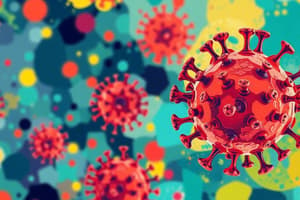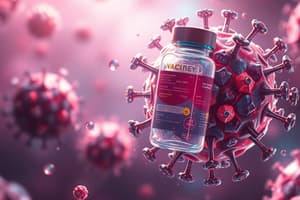Podcast
Questions and Answers
What is a disadvantage of attenuated vaccines in developing countries?
What is a disadvantage of attenuated vaccines in developing countries?
- They are more expensive to produce.
- They cannot induce a strong immune response.
- They must be refrigerated to maintain effectiveness. (correct)
- They require multiple doses for effectiveness.
Why are inactivated vaccines considered safer than attenuated vaccines?
Why are inactivated vaccines considered safer than attenuated vaccines?
- They do not require booster shots.
- They cannot mutate to cause disease. (correct)
- They produce a stronger immune response.
- They are easier to store at lower temperatures.
What is the basis of toxoid vaccines?
What is the basis of toxoid vaccines?
- They contain fragments of DNA from the pathogens.
- They are made from inactivated bacterial toxins. (correct)
- They consist of whole killed viruses.
- Live pathogens are used to generate an immune response.
What is a key requirement for maintaining immunity from inactivated vaccines?
What is a key requirement for maintaining immunity from inactivated vaccines?
What advantage do second-generation vaccines have over traditional vaccines?
What advantage do second-generation vaccines have over traditional vaccines?
Which of the following vaccines would typically require booster shots?
Which of the following vaccines would typically require booster shots?
What is a drawback associated with inactivated vaccines?
What is a drawback associated with inactivated vaccines?
What might be a reason combination vaccines are not always effective?
What might be a reason combination vaccines are not always effective?
What is the main advantage of attenuated vaccines compared to other types of vaccines?
What is the main advantage of attenuated vaccines compared to other types of vaccines?
Which of the following vaccines is an example of an attenuated vaccine?
Which of the following vaccines is an example of an attenuated vaccine?
What is a significant risk associated with attenuated vaccines?
What is a significant risk associated with attenuated vaccines?
Who should avoid receiving attenuated vaccines?
Who should avoid receiving attenuated vaccines?
How does the immune system respond upon later exposure to the same antigen after vaccination?
How does the immune system respond upon later exposure to the same antigen after vaccination?
What method is often used to reduce the number of injections for immunization?
What method is often used to reduce the number of injections for immunization?
What is a characteristic of attenuated microorganisms used in vaccines?
What is a characteristic of attenuated microorganisms used in vaccines?
What characterizes active immunity?
What characterizes active immunity?
What is the FDA-approved combination vaccine called that protects against multiple diseases for children?
What is the FDA-approved combination vaccine called that protects against multiple diseases for children?
Which statement accurately describes naturally acquired active immunity?
Which statement accurately describes naturally acquired active immunity?
What enables memory cells to produce antibodies during a secondary antibody response?
What enables memory cells to produce antibodies during a secondary antibody response?
What is the primary function of vaccines?
What is the primary function of vaccines?
How does artificially acquired active immunity differ from naturally acquired immunity?
How does artificially acquired active immunity differ from naturally acquired immunity?
What type of immunity is described as less risky and easier to acquire?
What type of immunity is described as less risky and easier to acquire?
Which is NOT a characteristic of a vaccine?
Which is NOT a characteristic of a vaccine?
What is a common outcome of a primary antibody response triggered by vaccination?
What is a common outcome of a primary antibody response triggered by vaccination?
What is the primary reason vaccinations do not need to reach 100% of the population?
What is the primary reason vaccinations do not need to reach 100% of the population?
What is the herd immunity threshold percentage believed by microbiologists and epidemiologists?
What is the herd immunity threshold percentage believed by microbiologists and epidemiologists?
Which population setting poses a higher risk for unvaccinated individuals catching diseases?
Which population setting poses a higher risk for unvaccinated individuals catching diseases?
What factor affects the success of herd immunity apart from vaccination rates?
What factor affects the success of herd immunity apart from vaccination rates?
Why might some individuals remain susceptible to diseases even when most of the population is immunized?
Why might some individuals remain susceptible to diseases even when most of the population is immunized?
How long do maternal IgG antibodies typically remain in a child after birth?
How long do maternal IgG antibodies typically remain in a child after birth?
What is the predominant antibody found in colostrum?
What is the predominant antibody found in colostrum?
What is the purpose of artificially acquired passive immunity?
What is the purpose of artificially acquired passive immunity?
What term describes serum with a higher-than-normal level of a particular antibody?
What term describes serum with a higher-than-normal level of a particular antibody?
Which type of serum is used to treat an established disease?
Which type of serum is used to treat an established disease?
What is herd immunity primarily concerned with?
What is herd immunity primarily concerned with?
What can happen to a population with insufficient vaccination coverage?
What can happen to a population with insufficient vaccination coverage?
What is the primary feature of a subunit vaccine?
What is the primary feature of a subunit vaccine?
What is gamma globulin primarily composed of?
What is gamma globulin primarily composed of?
Which statement accurately describes conjugate vaccines?
Which statement accurately describes conjugate vaccines?
What role does mRNA play in an mRNA vaccine?
What role does mRNA play in an mRNA vaccine?
How does passive immunity differ from active immunity?
How does passive immunity differ from active immunity?
What is naturally acquired passive immunity?
What is naturally acquired passive immunity?
What is a common aspect of the adverse reactions to subunit vaccines?
What is a common aspect of the adverse reactions to subunit vaccines?
Which of the following vaccines is an example of a conjugate vaccine?
Which of the following vaccines is an example of a conjugate vaccine?
What initiates the immune response in mRNA vaccines?
What initiates the immune response in mRNA vaccines?
Flashcards
Active Immunity
Active Immunity
When your immune system creates antibodies to fight off a disease, either naturally due to infection or artificially through vaccination.
Naturally Acquired Active Immunity
Naturally Acquired Active Immunity
Developing immunity after getting a disease and recovering naturally.
Artificially Acquired Active Immunity
Artificially Acquired Active Immunity
Developing immunity through vaccination, where exposure to a safe version of the disease causes your body to build defenses.
Vaccines
Vaccines
Signup and view all the flashcards
Primary Antibody Response
Primary Antibody Response
Signup and view all the flashcards
Secondary Antibody Response
Secondary Antibody Response
Signup and view all the flashcards
Memory cells
Memory cells
Signup and view all the flashcards
Antigen
Antigen
Signup and view all the flashcards
Attenuated Vaccine
Attenuated Vaccine
Signup and view all the flashcards
How do attenuated vaccines work?
How do attenuated vaccines work?
Signup and view all the flashcards
Examples of Attenuated Vaccines
Examples of Attenuated Vaccines
Signup and view all the flashcards
Benefits of Attenuated Vaccines
Benefits of Attenuated Vaccines
Signup and view all the flashcards
Downsides of Attenuated Vaccines
Downsides of Attenuated Vaccines
Signup and view all the flashcards
Who should avoid attenuated vaccines?
Who should avoid attenuated vaccines?
Signup and view all the flashcards
Combination Vaccines
Combination Vaccines
Signup and view all the flashcards
Why are combination vaccines useful?
Why are combination vaccines useful?
Signup and view all the flashcards
Inactivated Vaccines
Inactivated Vaccines
Signup and view all the flashcards
Toxoid Vaccines
Toxoid Vaccines
Signup and view all the flashcards
Booster Shots
Booster Shots
Signup and view all the flashcards
Subunit Vaccines
Subunit Vaccines
Signup and view all the flashcards
Conjugate Vaccines
Conjugate Vaccines
Signup and view all the flashcards
Cytotoxic T-cell Response
Cytotoxic T-cell Response
Signup and view all the flashcards
Why are inactivated vaccines favored in developing nations?
Why are inactivated vaccines favored in developing nations?
Signup and view all the flashcards
Epitope
Epitope
Signup and view all the flashcards
Haemophilus influenzae b (Hib)
Haemophilus influenzae b (Hib)
Signup and view all the flashcards
RNA Vaccine
RNA Vaccine
Signup and view all the flashcards
Maternal Antibodies
Maternal Antibodies
Signup and view all the flashcards
Colostrum
Colostrum
Signup and view all the flashcards
Artificially Acquired Passive Immunity
Artificially Acquired Passive Immunity
Signup and view all the flashcards
Antiserum
Antiserum
Signup and view all the flashcards
Hyperimmune Serum
Hyperimmune Serum
Signup and view all the flashcards
Gamma Globulin
Gamma Globulin
Signup and view all the flashcards
Herd Immunity
Herd Immunity
Signup and view all the flashcards
Vulnerability to Epidemics
Vulnerability to Epidemics
Signup and view all the flashcards
Herd Immunity Threshold
Herd Immunity Threshold
Signup and view all the flashcards
Factors Affecting Herd Immunity
Factors Affecting Herd Immunity
Signup and view all the flashcards
How Does Herd Immunity Protect the Unvaccinated?
How Does Herd Immunity Protect the Unvaccinated?
Signup and view all the flashcards
Why is 100% Vaccination Not Necessary?
Why is 100% Vaccination Not Necessary?
Signup and view all the flashcards
Study Notes
Pharmaceutical Microbiology: Immunology
- Active immunity: Antigen exposure triggers the immune system to produce antibodies and specific lymphocytes. This exposure can be unintentional (catching a disease) or intentional (vaccines).
Naturally Acquired Active Immunity
-
Before widespread vaccines, this was the only way to become immune. This involved getting a disease and recovering.
-
Subclinical diseases can also induce immunity - these diseases don't cause noticeable symptoms and still stimulate immunity.
-
Memory cells are critical in secondary antibody response, enabling rapid and robust immunity upon repeated exposure.
Artificially Acquired Active Immunity
-
This route is less risky than getting a disease.
-
Exposure to antigens occurs through vaccination (inactivated or toxoid vaccines). These inactivated agents don't cause disease.
Vaccines
-
Composed of treated microorganisms (chemicals, altered toxins, or parts of microorganisms).
-
Mimic a "natural" infection.
-
Trigger a primary immune response using the immune system's ability to recognize antigens and create antibodies and lymphocytes.
Attenuated Vaccines
-
Microbes are weakened in a lab to prevent disease.
-
Still capable of growth/replication at reduced rates; these microbes don't trigger full-blown disease.
-
Generate a strong immune response similar to a natural infection as they replicate, increasing the dose of antigen to which the immune system will respond.
-
Offer lifelong immunity.
-
Can spread to immunize others (reimmunization).
Inactivated Vaccines
-
Pathogens are killed using chemicals, heat, or radiation.
-
Weaken the immune response compared to live attenuated vaccines.
-
Inactivated vaccines, often require boosters, and can be stored at room temperature for easy access in regions without extensive cold storage facilities.
Toxoid Vaccines
-
Used in bacterial diseases (diphtheria, tetanus).
-
Inactivate bacterial toxins, not the bacteria themselves. This is done with formalin.
-
Induce immunity to these toxins.
-
Booster shots are typically needed.
Second-Generation Vaccines
- Designed to minimize vaccination risks. These contain only fragments of viruses or bacteria
- Subunit vaccines
- Conjugate vaccines
Subunit Vaccines
-
Contain specific parts (epitopes) of the antigen, stimulating a strong immune response.
-
Example: pneumococcal pneumonia, containing polysaccharides.
Conjugate Vaccines
-
Combine a polysaccharide component to a carrier protein. The carrier helps the immune system recognize and respond to the polysaccharide.
-
Enhanced immune response compared to polysaccharides alone.
-
Examples include Haemophilus influenzae type b (Hib) vaccine.
mRNA Vaccines
-
Deliver RNA to produce specific viral proteins.
-
Triggers an immune response without causing the disease.
-
Vaccines like Pfizer-BioNTech and Moderna COVID-19 vaccines are mRNA-based.
Passive Immunity
-
Antibodies are given from an outside source.
-
Contrast with active immunity, where the body produces antibodies on its own.
Naturally Acquired Passive Immunity
-
Antibodies transferred from mother to fetus (placenta, breast milk).
-
Provides short-term protection to the newborn.
Artificially Acquired Passive Immunity
-
Antibodies injected.
-
Provides rapid, short-term protection against diseases like poisonous bites.
Serum Rendered Artificially Acquired Passive Immunity
- Different terms for the antibodies: antiserum, hyper-immune serum, prophylactic serum, therapeutic serum, and convalescent serum.
Herd Immunity
-
When a large portion of a population is immune to a disease, it protects the susceptible portion from infection.
-
Crucial for disease control.
Studying That Suits You
Use AI to generate personalized quizzes and flashcards to suit your learning preferences.




